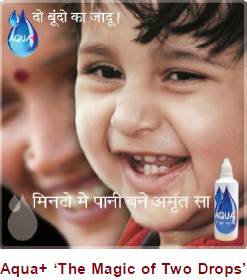Aqua+ : Safe Water for All and
Always
G
lobally, waterborne diseases caused by lack of safe drinking water and sanitation facilities kill more young children than AIDS, malaria and measles combined!1 It is estimated that 884 million people lack access to safe water worldwide. In India, it is estimated that around 37.7 million people are affected by waterborne diseases annually. Out of this, 1.5 million children are estimated to die of diarrhoea alone. The need for safe drinking water cannot be over emphasised.Traditionally viewed as a liability, the low income
household population segment of
 over
4 billion people is slowly emerging as an asset to the local, national and
global economy. With an approximate population of 700 million, India’s rural
low income household market presents itself as a significant opportunity not
only for multinational corporations but also for small and medium
manufacturers and producers2.
over
4 billion people is slowly emerging as an asset to the local, national and
global economy. With an approximate population of 700 million, India’s rural
low income household market presents itself as a significant opportunity not
only for multinational corporations but also for small and medium
manufacturers and producers2.
Technology and Action for Rural Advancement (TARA) has developed a framework to develop low cost water purification solutions. Using this framework, TARA has developed Aqua+, a water purification solution for the low income household market. TARA Aqua+ ‘The Magic of Two Drops’ is a 50ml bottle of Sodium Hypochlorite Solution (Liquid Chlorine). Each bottle of Aqua+ can purify 500 liters of water which is sufficient for a family of 5 members for 1 month. Since commercialisation in 2012, TARA has sold over 200,000 bottles of Aqua+ in different states of India such as Uttar Pradesh, Haryana, Kerala and Tamil Nadu.
TARA’s framework for Aqua+ consists of 3 major pillars – technology/product, delivery chain and demand creation.
Technology / Product
It is critically important that the product is locally relevant. Different areas have different problems, and a ‘one size fits all’ approach does not work. The product should be affordable but not cheap. The consumer understands the importance of quality. Since the consumer has limited disposable income, he or she would invest money in a risk-free and good quality value proposition. Aqua+ has been designed to disinfect water which is the main problem in most areas. It is affordable (as it costs less than INR 1.50 per day), easy to use (add two drops of Aqua+ per liter of water, wait for 30 minutes and the water is safe to drink) and aspirational (it provides households with ‘filter-like’ water at an affordable price).
Delivery Chain
The next important pillar is the delivery channel. It is critically important that the product is always and easily available to the customer. To ensure a financially viable supply chain, sufficient margin needs to be allocated for each member. To make the delivery chain truly sustainable, all margins should be incorporated in the price of the product. Thus there is no need to depend on subsidies or funding. For Aqua+, TARA taps into the existing distribution networks and has healthy margins (over 50% of the MRP) for stakeholders in the delivery chain.
Demand Creation
Most people do not realise that their drinking water is contaminated. So, it is crucial to create awareness. It is better to paint a picture of a better tomorrow than creating a doomsday scenario. Consumers respond better to the carrot than the stick. The social marketing campaign should be locally relevant, simple and continuous. Advertising the product on television will only have limited success. In the low income household market, a more personalised approach is required. For Aqua+, a social marketing toolkit has been developed which includes posters, jingles, street plays etc. These initial high-touch demand creation activities are crucial to start the process of behaviour change in the consumers.
In conclusion, to develop a sustainable business model to provide safe drinking water to the low income household market, all these 3 above mentioned pillars need to be adequately addressed. q
Siddhartha Bountra
sbountra@devalt.org
References
1 www.water.org
2 Shukla S. et el., 2011. ‘The Base of Pyramid distribution challenge: Evaluating alternate distribution models of energy products for rural Base of Pyramid in India’, Institute for Financial and Marketing Research